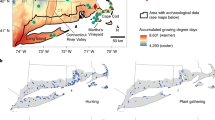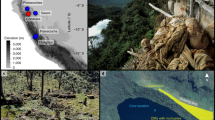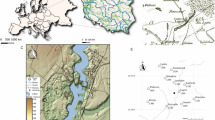Abstract
Palaeoecological reconstructions of the American Midwest during the last deglaciation suggest the expansion of parkland biomes lacking modern analogues. Despite their spatial extent and persistence over several millennia, the landscape configuration and environmental drivers for the ‘no analogue’ biomes remain speculative. Here we use regression analysis linking settlement-era forest composition and wetland extent to identify specific trees and forest units strongly indicative of high wetland prevalence. We then recompile a regional pollen time series to show transient increases in these flood-tolerant trees, with prominent peaks during the Bølling–Allerød interstadial (~14.6–12.8 thousand years ago). Taken together, the pollen records, and analyses of settlement-era forest composition and wetland prevalence, suggest the establishment of extensive deglacial wetlands in the American Midwest (40–60% of land cover). This extensive, yet transient, wetland was possibly supported by southward discharge of Laurentide Ice Sheet meltwater during the Bølling–Allerød. The timing of this wetland expansion and its mid-latitude location have implications for deglacial methane source dynamics; our estimate of ~11 Tg yr−1 of methane is comparable to the northern source enhancement modelled from ice-core records. Regional decline of the Laurentide Ice Sheet meltwater discharge at the onset of the Younger Dryas (~12.8–11.7 thousand years ago) explains in part why these no-analogue wetland-rich parklands sharply declined, weakening this potential methane source.
This is a preview of subscription content, access via your institution
Access options
Access Nature and 54 other Nature Portfolio journals
Get Nature+, our best-value online-access subscription
$29.99 / 30 days
cancel any time
Subscribe to this journal
Receive 12 print issues and online access
$259.00 per year
only $21.58 per issue
Buy this article
- Purchase on Springer Link
- Instant access to full article PDF
Prices may be subject to local taxes which are calculated during checkout



Similar content being viewed by others
Data availability
All data for this study is previously published and mostly available via public repositories. The settlement-era tree composition datasets62,63 are available from the Environmental Data Initiative, including gridded compilation of data for Minnesota, Wisconsin, Michigan and parts of Illinois and Indiana (https://doi.org/10.6073/pasta/aa0ef9828d41569a96651b056ad89fb3) and for the townships of Ohio (https://doi.org/10.6073/pasta/9df301adbfd619fa474e1041f0070c05), which the authors accessed through PalEON project website (http://paleonproject.org/). Water-table depth simulation results were published in ref. 46 and shared by contact with the first author. Time-series map images of North America biome reconstruction by ref. 15 were accessed via NOAA Paleo Data Search and are available to download at https://www.ncdc.noaa.gov/paleo/study/5973 (ref. 54). Global peatland simulation by ref. 14 is available to download at https://doi.org/10.3334/ORNLDAAC/1382 (ref. 55). Pollen datasets are available to view online using Neotoma Explorer at https://apps.neotomadb.org/explorer/ and to download by searching the web explorer as well as by using the ‘neotoma’ R package (https://CRAN.R-project.org/package=neotoma). The specific pollen records downloaded and analysed in this study are listed in Supplementary Table 1 in ascending order of the Neotoma assigned dataset ID. Source data for creation of Fig. 1c are available via the online versions of refs. 1,2,28,52 as supplementary tables.
Code availability
R scripts for reproducing plots and a more detailed step-by-step procedure for data acquisition, GIS analyses and machine-learning modelling are available in ref. 74 or by sending a request to E.B.
References
Bock, M. et al. Glacial/interglacial wetland, biomass burning, and geologic methane emissions constrained by dual stable isotopic CH4 ice core records. Proc. Natl Acad. Sci. USA 114, E5778–E5786 (2017).
Baumgartner, M. et al. High-resolution interpolar difference of atmospheric methane around the Last Glacial Maximum. Biogeosciences 9, 3961–3977 (2012).
Dyonisius, M. N. et al. Old carbon reservoirs were not important in the deglacial methane budget. Science 367, 907–910 (2020).
MacDonald, G. M. et al. Rapid early development of circumarctic peatlands and atmospheric CH4 and CO2 variations. Science 314, 285–288 (2006).
Yu, Z. et al. Evidence for elevated emissions from high-latitude wetlands contributing to high atmospheric CH4 concentration in the early Holocene. Glob. Biogeochem. Cycles 27, 131–140 (2013).
Nichols, J. E. & Peteet, D. M. Rapid expansion of northern peatlands and doubled estimate of carbon storage. Nat. Geosci. 12, 917–921 (2019).
Loisel, J. et al. Insights and issues with estimating northern peatland carbon stocks and fluxes since the Last Glacial Maximum. Earth Sci. Rev. 165, 59–80 (2017).
Zhao, Y. et al. Peatland initiation and carbon accumulation in China over the last 50,000 years. Earth Sci. Rev. 128, 139–146 (2014).
Köhler, P., Knorr, G. & Bard, E. Permafrost thawing as a possible source of abrupt carbon release at the onset of the Bølling/Allerød. Nat. Commun. 5, 5520 (2014).
Weitemeyer, K. A. & Buffett, B. A. Accumulation and release of methane from clathrates below the Laurentide and Cordilleran ice sheets. Glob. Planet. Change 53, 176–187 (2006).
Ridgwell, A., Maslin, M. & Kaplan, J. O. Flooding of the continental shelves as a contributor to deglacial CH4 rise. J. Quat. Sci. 27, 800–806 (2012).
deMenocal, P. et al. Abrupt onset and termination of the African Humid Period. Quat. Sci. Rev. 19, 347–361 (2000).
Byun, E., Finkelstein, S. A., Cowling, S. A. & Badiou, P. Potential carbon loss associated with post-settlement wetland conversion in southern Ontario, Canada. Carbon Balance Manag. 13, 6 (2018).
Stocker, B. D., Yu, Z., Massa, C. & Joos, F. Holocene peatland and ice-core data constraints on the timing and magnitude of CO2 emissions from past land use. Proc. Natl Acad. Sci. USA 114, 1492–1497 (2017).
Williams, J. W., Shuman, B. N., Webb, T., Bartlein, P. J. & Leduc, P. L. Late-Quaternary vegetation dynamics in North America: scailing from taxa to biomes. Ecol. Monogr. 74, 309–334 (2004).
Jackson, S. T. & Williams, J. W. Modern analogs in Quaternary paleoecology: here today, gone yesterday, gone tomorrow? Annu. Rev. Earth Planet. Sci. 32, 495–537 (2004).
Williams, J. W. & Jackson, S. T. Novel climates, no-analog communities, and ecological surprises. Front. Ecol. Environ. 5, 475–482 (2007).
Williams, J. W. Variations in tree cover in North America since the last glacial maximum. Glob. Planet. Change 35, 1–23 (2002).
Jones, R. A., Williams, J. W. & Jackson, S. T. Vegetation history since the Last Glacial Maximum in the Ozark highlands (USA): a new record from Cupola Pond, Missouri. Quat. Sci. Rev. 170, 174–187 (2017).
Gill, J. L., Williams, J. W., Jackson, S. T., Donnelly, J. P. & Schellinger, G. C. Climatic and megaherbivory controls on late-glacial vegetation dynamics: a new, high-resolution, multi-proxy record from Silver Lake, Ohio. Quat. Sci. Rev. 34, 66–80 (2012).
Gonzales, L. M., Williams, J. W. & Grimm, E. C. Expanded response-surfaces: a new method to reconstruct paleoclimates from fossil pollen assemblages that lack modern analogues. Quat. Sci. Rev. 28, 3315–3332 (2009).
Voelker, S. L. et al. Deglacial hydroclimate of midcontinental North America. Quat. Res. 83, 336–344 (2015).
Yansa, C. H. The timing and nature of late Quaternary vegetation changes in the northern Great Plains, USA and Canada: a re-assessment of the spruce phase. Quat. Sci. Rev. 25, 263–281 (2006).
Yansa, C. H., Dean, W. E. & Murphy, E. C. Late Quaternary paleoenvironments of an ephemeral wetland in North Dakota, USA: relative interactions of ground-water hydrology and climate change. J. Paleolimnol. 38, 441–457 (2007).
Yansa, C. H. & Adams, K. M. Mastodons and mammoths in the Great Lakes region, USA and Canada: new insights into their diets as they neared extinction.Geogr. Compass 6, 175–188 (2012).
Fildani, A., Hessler, A. M., Mason, C. C., McKay, M. P. & Stockli, D. F. Late Pleistocene glacial transitions in North America altered major river drainages, as revealed by deep-sea sediment. Sci. Rep. 8, 13839 (2018).
Miguez-Macho, G. & Fan, Y. The role of groundwater in the Amazon water cycle: 1. influence on seasonal streamflow, flooding and wetlands. J. Geophys. Res. Atmos. 117, D15113 (2012).
Wickert, A. D., Mitrovica, J. X., Williams, C. & Anderson, R. S. Gradual demise of a thin southern Laurentide Ice Sheet recorded by Mississippi drainage. Nature 502, 668–671 (2013).
Margold, M., Stokes, C. R. & Clark, C. D. Reconciling records of ice streaming and ice margin retreat to produce a palaeogeographic reconstruction of the deglaciation of the Laurentide Ice Sheet. Quat. Sci. Rev. 189, 1–30 (2018).
Bunting, M. J. & Warner, B. G. Hydroseral development in southern Ontario: patterns and controls. J. Biogeogr. 25, 3–18 (1998).
Curry, B. B. et al. The DeKalb mounds of northeastern Illinois as archives of deglacial history and postglacial environments. Quat. Res. 74, 82–90 (2010).
Lora, J. M. & Ibarra, D. E. The North American hydrologic cycle through the last deglaciation. Quat. Sci. Rev. 226, 105991 (2019).
Mendyk, Ł. et al. Environmental changes of a shallow kettle lake catchment in a young glacial landscape (Sumowskie Lake catchment), North-Central Poland. Quat. Int. 418, 116–131 (2016).
Dahl, T. E. & Zoltai, S. C. in Northern Forested Wetlands: Ecology and Management (eds. Trettin, C. C. et al.) 3–17 (CRC-Lewis Publishers, 1997).
Girardin, M. P., Tardif, J. & Bergeron, Y. Gradient analysis of Larix laricina dominated wetlands in Canada’s southeastern boreal forest. Can. J. Bot. 79, 444–456 (2001).
Thompson, D. K., Simpson, B. N. & Beaudoin, A. Using forest structure to predict the distribution of treed boreal peatlands in Canada. For. Ecol. Manag. 372, 19–27 (2016).
Shuman, B. N. & Marsicek, J. The structure of Holocene climate change in mid-latitude North America. Quat. Sci. Rev. 141, 38–51 (2016).
Lewis, C. F. M., Blasco, S. M. & Gareau, P. L. Glacial isostatic adjustment of the Laurentian Great Lakes basin: using the empirical record of strandline deformation for reconstruction of early Holocene paleo-lakes and discovery of a hydrologically closed phase. Géographie Phys. Quat. 59, 187–210 (2005).
Curry, B. B. et al. The Kankakee Torrent and other large meltwater flooding events during the last deglaciation, Illinois, USA. Quat. Sci. Rev. 90, 22–36 (2014).
Williams, J. W., Shuman, B., Bartlein, P. J., Diffenbaugh, N. S. & Webb, T. Rapid, time-transgressive, and variable responses to early Holocene midcontinental drying in North America. Geology 38, 135–138 (2010).
Van Meter, K. J. & Basu, N. B. Signatures of human impact: size distributions and spatial organization of wetlands in the Prairie Pothole landscape. Ecol. Appl. 25, 451–465 (2015).
Ott, C. A. & Chimner, R. A. Long-term peat accumulation in temperate forested peatlands (Thuja occidentalis swamps) in the Great Lakes region of North America. Mires Peat 18, 1 (2016).
Van Grinsven, M. et al. Response of black ash wetland gaseous soil carbon fluxes to a simulated emerald ash borer infestation. Forests 9, 324 (2018).
Lynch, E. A., Calcote, R., Hotchkiss, S. C. & Tweiten, M. Presence of lakes and wetlands decreases resilience of jack pine ecosystems to late-Holocene climatic changes. Can. J. For. Res. 44, 1331–1343 (2014).
Goring, S. J. et al. Novel and lost forests in the upper Midwestern United States, from new estimates of settlement-era composition, stem density, and biomass. PLoS ONE 11, e0151935 (2016).
Fan, Y., Li, H. & Miguez-Macho, G. Global patterns of groundwater table depth. Science 339, 940–943 (2013).
Plint, T., Longstaffe, F. J. & Zazula, G. Giant beaver palaeoecology inferred from stable isotopes. Sci. Rep. 9, 7179 (2019).
Sawada, M., Viau, A. E. & Gajewski, K. The biogeography of aquatic macrophytes in North America since the Last Glacial Maximum. J. Biogeogr. 30, 999–1017 (2003).
Buffam, I. et al. Integrating aquatic and terrestrial components to construct a complete carbon budget for a north temperate lake district. Glob. Change. Biol. 17, 1193–1211 (2011).
Wooller, M. J. et al. A new terrestrial palaeoenvironmental record from the Bering Land Bridge and context for human dispersal. R. Soc. Open Sci. 5, 180145 (2018).
Rostek, F. & Bard, E. Hydrological changes in eastern Europe during the last 40,000 yr inferred from biomarkers in Black Sea Sediments. Quat. Res. 80, 502–509 (2013).
Beck, J. et al. Bipolar carbon and hydrogen isotope constraints on the Holocene methane budget. Biogeosciences 15, 7155–7175 (2018).
Dyke, A. S., Moore, A. & Robertson, L. Deglaciation of North America Open File 1574 (Geological Survey of Canada, 2003); https://doi.org/10.4095/214399
Williams, J. W. et al. 2004 Late Quaternary North American Vegetation Dynamics Data (NOAA, accessed 26 February 2019); https://www.ncdc.noaa.gov/paleo/study/5973
Stocker, B. D., Yu, Z., Massa, C. & Joos, F. Global Peatland Carbon Balance and Land Use Change CO2 Emissions through the Holocene (ORNL DAAC, 2017); https://doi.org/10.3334/ORNLDAAC/1382
North America Rivers and Lakes (USGS, 2006); https://go.nature.com/2VPtPqo
Fildani, A. et al. The ancestral Mississippi drainage archived in the late Wisconsin Mississippi deep-sea fan. Geology 44, 479–482 (2016).
Margold, M., Stokes, C. R., Clark, C. D. & Kleman, J. Ice streams in the Laurentide Ice Sheet: a new mapping inventory. J. Maps 11, 380–395 (2015).
Goring, S. et al. neotoma: a programmatic interface to the neotoma paleoecological database. Open Quat. 1, 2 (2015).
Dawson, A. et al. Quantifying pollen–vegetation relationships to reconstruct ancient forests using 19th-century forest composition and pollen data. Quat. Sci. Rev. 137, 156–175 (2016).
Williams, J. W., Shuman, B. & Bartlein, P. J. Rapid responses of the prairie-forest ecotone to early Holocene aridity in mid-continental North America. Glob. Planet. Change 66, 195–207 (2009).
Goring, S. Settlement-Era Gridded Tree Composition, Midwestern US: Level 1 (Environmental Data Initiative, accessed 22 April 2019); https://doi.org/10.6073/pasta/aa0ef9828d41569a96651b056ad89fb3
Cogbill, C. Settlement-Era Tree Composition, Ohio: Level 1 (Environmental Data Initiative, accessed 22 April 2019); https://doi.org/10.6073/pasta/9df301adbfd619fa474e1041f0070c05
Fan, Y. & Miguez-Macho, G. A simple hydrologic framework for simulating wetlands in climate and Earth system models. Clim. Dyn. 37, 253–278 (2011).
Paciorek, C. J. et al. Statistically-estimated tree composition for the northeastern United States at Euro-American settlement. PLoS ONE 11, e0150087 (2016).
Shmueli, G. To explain or to predict? Stat. Sci. 25, 289–310 (2010).
De’Ath, G. & Fabricius, K. E. Classification and regression trees: a powerful yet simple technique for ecological data analysis. Ecology 81, 3178–3192 (2000).
Grömping, U. Variable importance in regression models. Wiley Interdiscip. Rev. Comput. Stat. 7, 137–152 (2015).
Cutler, D. R. et al. Random forests for classification in ecology. Ecology 88, 2783–2792 (2007).
Delcourt, H. R. & Delcourt, P. A. Postglacial rise and decline of Ostrya virginiana (Mill.) K. Koch and Carpinus caroliniana Walt. in eastern North America: predictable responses of forest species to cyclic changes in seasonality of climates. J. Biogeogr. 21, 137–150 (1994).
Yu, Z. & Wright, H. E. J. Response of interior North America to abrupt climate oscillations in the North Atlantic region during the last deglaciation. Earth Sci. Rev. 52, 333–369 (2001).
Teller, J. T. Volume and routing of late-glacial runoff from the southern Laurentide Ice Sheet. Quat. Res. 34, 12–23 (1990).
Wickert, A. D. Reconstruction of North American drainage basins and river discharge since the Last Glacial Maximum. Earth Surf. Dyn. 4, 831–869 (2016).
Byun, E. The Underestimated Role of Temperate Wetlands in the Late Quaternary Terrestrial Carbon Cycle. PhD thesis, Univ. Toronto (2020).
Acknowledgements
We acknowledge funding for this research from the University of Toronto Centre for Global Change Science and the Connaught International Scholarship for Doctoral Students to E.B. and from the Natural Sciences and Engineering Research Council (Canada) to S.A.F. and S.A.C. We thank the many contributors to the Neotoma database for making pollen datasets available for further analyses, and we thank Y. Fan for sharing the water-table depth simulation results.
Author information
Authors and Affiliations
Contributions
E.B. conceived the study with guidance from S.A.F. and S.A.C.; E.B. obtained the datasets, performed the analyses and wrote the first draft of the manuscript with input from H.S and S.A.F. H.S. contributed to validation of methodology. S.A.F. contributed to writing of the final draft. All authors contributed to the interpretation of the results and contributed to revising and improving the text and figures.
Corresponding authors
Ethics declarations
Competing interests
The authors declare no competing interests.
Additional information
Peer review information Primary Handling Editor: James Super.
Publisher’s note Springer Nature remains neutral with regard to jurisdictional claims in published maps and institutional affiliations.
Supplementary information
Supplementary Information
Supplementary Figs. 1–15 and Tables 2–6.
Supplementary Table 1
List of Neotoma pollen records used in this study.
Rights and permissions
About this article
Cite this article
Byun, E., Sato, H., Cowling, S.A. et al. Extensive wetland development in mid-latitude North America during the Bølling–Allerød. Nat. Geosci. 14, 30–35 (2021). https://doi.org/10.1038/s41561-020-00670-4
Received:
Accepted:
Published:
Issue Date:
DOI: https://doi.org/10.1038/s41561-020-00670-4
This article is cited by
-
Past permafrost dynamics can inform future permafrost carbon-climate feedbacks
Communications Earth & Environment (2023)



